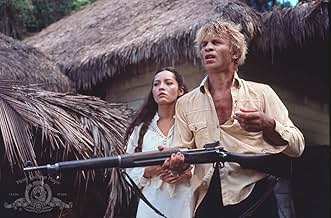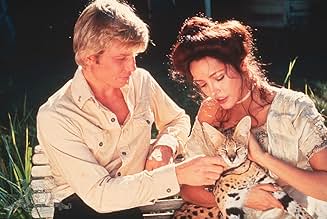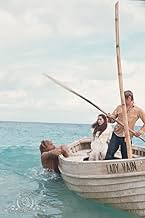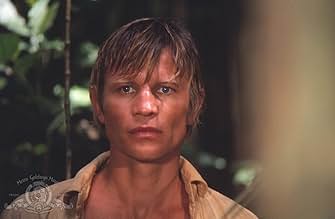Ein schiffbrüchiger Überlebender entdeckt eine abgelegene Insel, die einem verrückten Wissenschaftler gehört, der unheimliche Experimente an den Bewohnern der Insel durchführt.Ein schiffbrüchiger Überlebender entdeckt eine abgelegene Insel, die einem verrückten Wissenschaftler gehört, der unheimliche Experimente an den Bewohnern der Insel durchführt.Ein schiffbrüchiger Überlebender entdeckt eine abgelegene Insel, die einem verrückten Wissenschaftler gehört, der unheimliche Experimente an den Bewohnern der Insel durchführt.
- Auszeichnungen
- 6 Nominierungen insgesamt
Empfohlene Bewertungen
Nigel Davenport plays the boozy mercenary protecting the island establishment from its own macabre experiments, while Richard Basehart is a transformed animal, human enough to be the law sayer and peace-keeper of the mutated island population. Then there's the ravishing Barbara Carrera as a naive orphan brought to the island as a child by Moreau, besotted by the chivalrous York, but equally mysterious like her young lynx companion. Nick Cravat and Dave Cass have minor supporting roles as manimals of various pedigree.
The second reason to tune in is the set design and make-up effects in which luminaries John Chambers and Dan Striepeke were involved. Moreau's half-breed experiments are impressively brought to life by Chambers' crew, the full effect more evident on close-up, particularly on the unrecognisable Basehart.
Finally, if it needs to be defended, the production of Samuel Z.Arkoff and Sandy Howard should please some, their AIP distribution lending a certain B-movie prestige, a badge that will in itself, attract a legion of fans (but equally, render others suspicious of the quality). Overall, while there were a plethora of plot-holes to be found, and the conclusion a little simplistic, the general tone and quality of the film remained highly entertaining, uncomplicated and straightforward, something the 1996 remake couldn't muster in spite of its (by relative standards) gold plated production.
This is another take on the H. G. Wells novel about the "mad" scientist experimenting with animals on a South Seas island, performing surgery on them in "the House of Pain" to try to transform them into human beings. Of course, things never go as planned in these films. Moreau is, after all, "tampering in God's domain" (though that hoary old expression is mercifully not used in this film).
Difficult to not compare this version to the first adaption, 1933's Island of Lost Souls, which I find far more satisfactory. In the original Charles Laughton brought a creepy, perverse quality to his Moreau. He was unsettling but effective, and when he cracked that whip in the "What is the law?" scene with the man beasts there was more than a hint of the sadist about him.
The surprising casting of Burt Lancaster as Moreau in the 1977 version fails to bring any of these same odious qualities to the film. It's difficult to work up much of a dislike for Lancaster's scientist in spite of his activities. He's still Burt, and he has to battle against his good guy screen persona.
Island of Dr. Moreau also surprisingly jettisons one of the kinkiest aspects of the 1933 film, the Panther Girl, as originally played by Kathleen Burke, his most near perfection human like creation from a beast, with whom Laughton's Moreau is eager to see if an unsuspecting male shipwrecked on his island (Richard Arlen) will be willing to mate.
The '77 version does have beautiful Barbara Carrera slinking around, and she certainly intrigues (well, more than intrigues) Michael York, now in the Arlen role. Lancaster is aware that they are sexually attracted to each other and ready to mate - but to what purpose, since it turns out Carrera is a normal human, and no kind of Panther Girl. There is a hint in her final scene, however, that she may not be quite so normal, after all, but it went by so quickly I wasn't quite certain if it was my imagination.
The man beasts in the original are more effective than here. For starters, you didn't get a really good look at the makeup in the original (outside of a closeup of Bela Lugosi), so much of it is left to the audience's imagination. In the '77 version you see the makeup and, to be honest, it's not so much frightening as it is artificial in appearance (on about a par with that to be found in the original Planet of the Apes).
The '77 version, however, interestingly, does show what happens to the man beasts after everything blows up on the island, something the '33 original left to our imagination. This version also has Moreau strapping down and experimenting with York, something not done in the '33 version. That is one of the more interesting aspects of this production, as well.
In the final analysis, this is a fairly mediocre adaption of the Wells story, but one should still see it to make his own assessment. There would be another version with Brando almost 20 years later, of course. It's been too long since I've seen that version to talk about it, though I do recall disliking it at the time.
When Braddock protests at the cruel treatment of the creatures, Dr Moreau attempts to justify his experiments by explaining that by doing so, humanity would be benefited by elimination of birth defects and such, but Braddock is unconvinced.
Though they are repulsive-looking in appearance, the viewer can't help but sympathize with the plight of the "manimals", who live together in squalor in a dark cave, kept in line by The Laws established by Moreau - do not kill, do not shed blood, do not walk on all fours, etc. - repeated on an almost daily basis by their apparent leader the Sayer of the Law (Richard Baseheart), who looks the most "human" and "civilized" of the lot. Infractions of the Law results in being brought to the so-called House of Pain, where Moreau attempts to "correct" the miscreant and remind him that he is human and not animal.
The turning point in the film is when the Bullman (obviously originally a bison by the presence of a hairy hump on his back), having broken the law of shedding blood, attempts to flee rather than face punishment and is gunned down by Braddock. Yet despite having broken the law against killing, Braddock goes apparently unpunished, establishing in the minds of the other man-beasts of the unfairness of the Law - they seem to ask silently, why can this man kill and go scot-free and we can't?, and the eventual murder of Montgomery at the hands of Dr Moreau himself reinforces the double-standards of The Law in their eyes, and they eventually rise and revolt against the doctor, killing him, destroying the compound in which he lives in and setting it on fire. Ironically, it is this very act of staging a collective uprising which brings out the "humanity" of the creatures, as it shows that they can after all, think and plan and not merely act on their basic instincts, as the scenes where they suspend the doctor on a rope and systematically destroy the House of Pain and release the captive animals show. So in a way, Dr Moreau's experiments were not a total failure as he thought, they just didn't turn out the way he anticipated.
** 1/2 (out of 4)
Andrew Braddock (Michael York) shipwrecks and eventually washes up on a jungle island. Once there he is introduced to Dr. Moreau (Burt Lancaster) who at first seems like a nice guy simply doing research. Pretty soon Andrew begins to realize that the doctor is doing strange experiments between men and animals and the result are some mutated creatures living in the jungle.
Whenever people speak about the H.G. Wells adaptations of this story, it seems this one here is forgotten and sometimes it doesn't even come up. Of course, they always discuss the greatness of 1932's ISLAND OF LOST SOULS and they always discuss the disastrous Marlon Brando version. Why is this film from 1977 rarely mentioned? I'm going to guess because it's not really a flat-out horror movie. The majority of its running time it appears to be trying to be a real medical drama and a showcase for Lancaster.
Is that a bad thing? I personally don't think so but it does make for a rather slow running time and I'm sure some people would have preferred more horror elements or more of a spotlight being placed on the creatures. With that said, I think this is a mildly entertaining movie thanks in large part to the performances in the film. Lancaster always carried himself with such grace that he had no problem fitting into this role to where people could see this character and think that he was a good man. I thought Lancaster was good in the part, although the screenplay never really allowed him a chance to go crazy or mad.
York was also good in the lead role, although his character too suffers from not getting too much to do until the very end. Nigel Davenport is good in the supporting role as the doctor's help and Barbara Carrera made for a good love interest. Richard Basehart got to play the role originated by Bela Lugosi and I couldn't help but think that Basehart had seen the earlier version and remembered Lugosi's performance.
With all of that said, the film really does come to life during the final fifteen-minutes once the creatures decide that they have had enough. I thought the various animals that were used were great and I also thought the action was nice. There were some tense moments that happened during the final action sequence so overall the film at least goes out on a good note.
Wusstest du schon
- WissenswertesDuring the fight between the bullman and the tiger, the animal actually took the stuntman's head in his jaws. Luckily he was wearing a fiberglass helmet which protected him.
- PatzerDuring the opening scene when the boat is being pushed ashore you can see the shadow of the boom mic in the water's edge.
- Zitate
Sayer of the Law: [about Moreau] His is the hand that makes. His is the hand that hurts. His is the hand that heals. His is the House of Pain. His is the House of Pain. His is the House of Pain. He who breaks the law shall be punished back to the House of Pain.
- VerbindungenFeatured in A Century of Science Fiction (1996)
- SoundtracksDer Vogelfänger bin ich ja
(Papageno's Aria from "Die Zauberflöte" K.620)
Written by Wolfgang Amadeus Mozart
Top-Auswahl
Details
- Erscheinungsdatum
- Herkunftsland
- Offizieller Standort
- Sprache
- Auch bekannt als
- The Island of Dr. Moreau
- Drehorte
- St. Croix, Amerikanische Jungferninseln(location)
- Produktionsfirmen
- Weitere beteiligte Unternehmen bei IMDbPro anzeigen
Box Office
- Budget
- 6.000.000 $ (geschätzt)
Zu dieser Seite beitragen






























